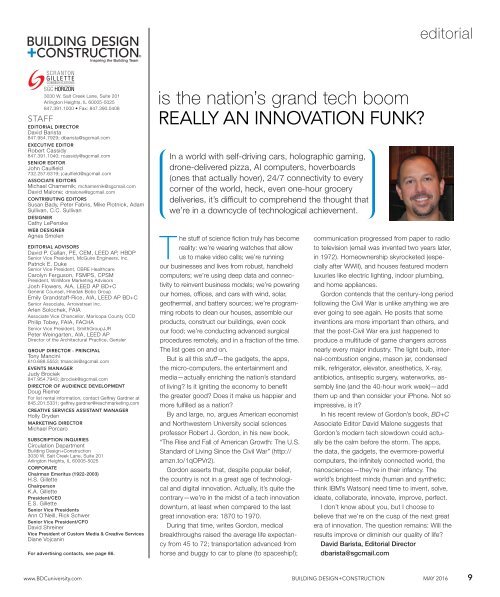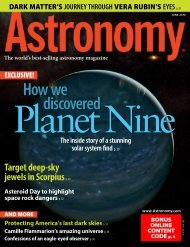Building Design Construction
Create successful ePaper yourself
Turn your PDF publications into a flip-book with our unique Google optimized e-Paper software.
editorial<br />
3030 W. Salt Creek Lane, Suite 201<br />
Arlington Heights, IL 60005-5025<br />
847.391.1000 • Fax: 847.390.0408<br />
STAFF<br />
EDITORIAL DIRECTOR<br />
David Barista<br />
847.954.7929; dbarista@sgcmail.com<br />
EXECUTIVE EDITOR<br />
Robert Cassidy<br />
847.391.1040; rcassidy@sgcmail.com<br />
SENIOR EDITOR<br />
John Caulfield<br />
732.257.6319; jcaulfield@sgcmail.com<br />
ASSOCIATE EDITORS<br />
Michael Chamernik; mchamernik@sgcmail.com<br />
David Malone; dmalone@sgcmail.com<br />
CONTRIBUTING EDITORS<br />
Susan Bady, Peter Fabris, Mike Plotnick, Adam<br />
Sullivan, C.C. Sullivan<br />
DESIGNER<br />
Cathy LePenske<br />
WEB DESIGNER<br />
Agnes Smolen<br />
EDITORIAL ADVISORS<br />
David P. Callan, PE, CEM, LEED AP, HBDP<br />
Senior Vice President, McGuire Engineers, Inc.<br />
Patrick E. Duke<br />
Senior Vice President, CBRE Healthcare<br />
Carolyn Ferguson, FSMPS, CPSM<br />
President, WinMore Marketing Advisors<br />
Josh Flowers, AIA, LEED AP BD+C<br />
General Counsel, Hnedak Bobo Group<br />
Emily Grandstaff-Rice, AIA, LEED AP BD+C<br />
Senior Associate, Arrowstreet Inc.<br />
Arlen Solochek, FAIA<br />
Associate Vice Chancellor, Maricopa County CCD<br />
Philip Tobey, FAIA, FACHA<br />
Senior Vice President, SmithGroupJJR<br />
Peter Weingarten, AIA, LEED AP<br />
Director of the Architectural Practice, Gensler<br />
GROUP DIRECTOR - PRINCIPAL<br />
Tony Mancini<br />
610.688.5553; tmancini@sgcmail.com<br />
EVENTS MANAGER<br />
Judy Brociek<br />
847.954.7943; jbrociek@sgcmail.com<br />
DIRECTOR OF AUDIENCE DEVELOPMENT<br />
Doug Riemer<br />
For list rental information, contact Geffrey Gardner at<br />
845.201.5331; geffrey.gardner@reachmarketing.com<br />
CREATIVE SERVICES ASSISTANT MANAGER<br />
Holly Dryden<br />
MARKETING DIRECTOR<br />
Michael Porcaro<br />
SUBSCRIPTION INQUIRIES<br />
Circulation Department<br />
<strong>Building</strong> <strong>Design</strong>+<strong>Construction</strong><br />
3030 W. Salt Creek Lane, Suite 201<br />
Arlington Heights, IL 60005-5025<br />
CORPORATE<br />
Chairman Emeritus (1922-2003)<br />
H.S. Gillette<br />
Chairperson<br />
K.A. Gillette<br />
President/CEO<br />
E.S. Gillette<br />
Senior Vice Presidents<br />
Ann O’Neill, Rick Schwer<br />
Senior Vice President/CFO<br />
David Shreiner<br />
Vice President of Custom Media & Creative Services<br />
Diane Vojcanin<br />
For advertising contacts, see page 86.<br />
is the nation’s grand tech boom<br />
REALLY AN INNOVATION FUNK?<br />
In a world with self-driving cars, holographic gaming,<br />
drone-delivered pizza, AI computers, hoverboards<br />
(ones that actually hover), 24/7 connectivity to every<br />
corner of the world, heck, even one-hour grocery<br />
deliveries, it’s diffi cult to comprehend the thought that<br />
we’re in a downcycle of technological achievement.<br />
The stuff of science fi ction truly has become<br />
reality: we’re wearing watches that allow<br />
us to make video calls; we’re running<br />
our businesses and lives from robust, handheld<br />
computers; we’re using deep data and connectivity<br />
to reinvent business models; we’re powering<br />
our homes, offi ces, and cars with wind, solar,<br />
geothermal, and battery sources; we’re programming<br />
robots to clean our houses, assemble our<br />
products, construct our buildings, even cook<br />
our food; we’re conducting advanced surgical<br />
procedures remotely, and in a fraction of the time.<br />
The list goes on and on.<br />
But is all this stuff—the gadgets, the apps,<br />
the micro-computers, the entertainment and<br />
media—actually enriching the nation’s standard<br />
of living? Is it igniting the economy to benefi t<br />
the greater good? Does it make us happier and<br />
more fulfi lled as a nation?<br />
By and large, no, argues American economist<br />
and Northwestern University social sciences<br />
professor Robert J. Gordon, in his new book,<br />
“The Rise and Fall of American Growth: The U.S.<br />
Standard of Living Since the Civil War” (http://<br />
amzn.to/1qOPVr2).<br />
Gordon asserts that, despite popular belief,<br />
the country is not in a great age of technological<br />
and digital innovation. Actually, it’s quite the<br />
contrary—we’re in the midst of a tech innovation<br />
downturn, at least when compared to the last<br />
great innovation era: 1870 to 1970.<br />
During that time, writes Gordon, medical<br />
breakthroughs raised the average life expectancy<br />
from 45 to 72; transportation advanced from<br />
horse and buggy to car to plane (to spaceship!);<br />
communication progressed from paper to radio<br />
to television (email was invented two years later,<br />
in 1972). Homeownership skyrocketed (especially<br />
after WWII), and houses featured modern<br />
luxuries like electric lighting, indoor plumbing,<br />
and home appliances.<br />
Gordon contends that the century-long period<br />
following the Civil War is unlike anything we are<br />
ever going to see again. He posits that some<br />
inventions are more important than others, and<br />
that the post-Civil War era just happened to<br />
produce a multitude of game changers across<br />
nearly every major industry. The light bulb, internal-combustion<br />
engine, mason jar, condensed<br />
milk, refrigerator, elevator, anesthetics, X-ray,<br />
antibiotics, antiseptic surgery, waterworks, assembly<br />
line (and the 40-hour work week)—add<br />
them up and then consider your iPhone. Not so<br />
impressive, is it?<br />
In his recent review of Gordon’s book, BD+C<br />
Associate Editor David Malone suggests that<br />
Gordon’s modern tech slowdown could actually<br />
be the calm before the storm. The apps,<br />
the data, the gadgets, the evermore-powerful<br />
computers, the infi nitely connected world, the<br />
nanosciences—they’re in their infancy. The<br />
world’s brightest minds (human and synthetic;<br />
think IBM’s Watson) need time to invent, solve,<br />
ideate, collaborate, innovate, improve, perfect.<br />
I don’t know about you, but I choose to<br />
believe that we’re on the cusp of the next great<br />
era of innovation. The question remains: Will the<br />
results improve or diminish our quality of life?<br />
David Barista, Editorial Director<br />
dbarista@sgcmail.com<br />
www.BDCuniversity.com BUILDING DESIGN+CONSTRUCTION MAY 2016 9






